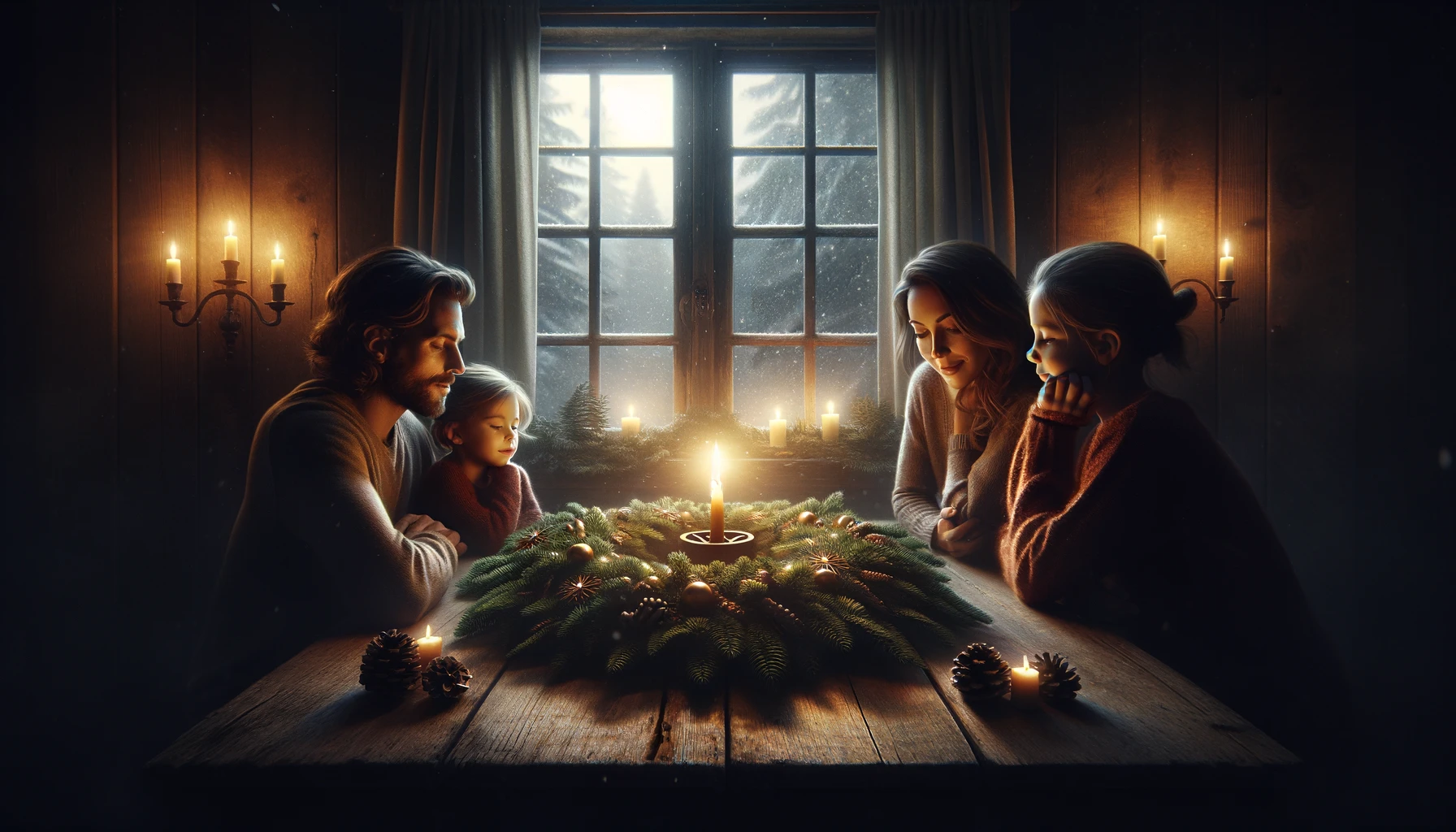Home>Special Themes>What Is The Meaning Of The Third Sunday Of Advent


Special Themes
What Is The Meaning Of The Third Sunday Of Advent
Published: February 12, 2024
Peter Smith, Editorial Director at Christian.net, combines deep insights into faith, politics, and culture to lead content creation that resonates widely. Awarded for his contributions to religious discourse, he previously headed a major organization for religious communicators, enhancing dialogue on faith's societal impacts.
Discover the significance of the Third Sunday of Advent and its special themes. Explore the meaning and traditions of this important liturgical day.
(Many of the links in this article redirect to a specific reviewed product. Your purchase of these products through affiliate links helps to generate commission for Christian.net, at no extra cost. Learn more)
Table of Contents
Introduction
The Third Sunday of Advent, also known as Gaudete Sunday, is a significant and joyous occasion within the Christian liturgical calendar. As the midpoint of the Advent season, this day holds a special place in the hearts of believers as they prepare for the celebration of the birth of Jesus Christ. The term "Advent" is derived from the Latin word "adventus," meaning "coming" or "arrival," signifying the anticipation of the arrival of Christ.
This particular Sunday is marked by a shift in tone, as the somber reflection of the preceding weeks gives way to a sense of joyful anticipation. The liturgical color changes from the traditional purple to rose, symbolizing the lightening of the spiritual atmosphere as the celebration of Christ's birth draws nearer.
Gaudete Sunday offers a moment of respite and encouragement for the faithful, reminding them of the imminent joy that the birth of Jesus brings. It serves as a reminder that even amidst the solemn preparation for Christ's coming, there is cause for rejoicing.
The observance of Gaudete Sunday is not only a time of spiritual reflection and anticipation but also a celebration of the hope and joy that Christ's birth represents. It is a time for believers to reflect on the profound significance of the Incarnation and to rejoice in the promise of salvation.
As we delve deeper into the history, symbolism, and significance of the Third Sunday of Advent, we will uncover the rich tapestry of traditions and practices that have evolved around this pivotal moment in the liturgical calendar. This exploration will provide a deeper understanding of the spiritual and cultural importance of Gaudete Sunday and how it continues to resonate with believers around the world.
Read more: What Is Third Sunday Of Advent Called
The History of Advent
The history of Advent can be traced back to the early centuries of Christianity. The origins of Advent can be linked to the preparation for the celebration of the birth of Jesus Christ. While the exact date of the establishment of Advent as a liturgical season is not definitively known, it is believed to have emerged in the 4th or 5th century in Gaul (modern-day France).
Initially, Advent was a period of fasting and preparation for the feast of the Epiphany, which commemorates the manifestation of Christ to the Gentiles. Over time, the focus of Advent shifted to the anticipation of the Nativity of Christ, and the season evolved to reflect this change.
The structure and duration of Advent have varied throughout history and across different Christian traditions. In the early days, Advent was observed for five weeks, mirroring the 40-day period of Lent. However, in the 6th century, Pope Gregory the Great established the four-week Advent season that is widely recognized today.
The themes of Advent, including hope, peace, joy, and love, gradually became integrated into the liturgical practices of the season. The lighting of Advent candles, the use of the Advent wreath, and the reading of specific biblical passages during each week of Advent became customary observances.
The historical significance of Advent is deeply rooted in the anticipation of the coming of Christ, not only as a historical event but also as a future promise. It serves as a time of spiritual preparation, repentance, and expectation, inviting believers to reflect on the profound mystery of the Incarnation and the redemptive mission of Jesus Christ.
As Advent continues to be observed in various Christian denominations, its historical legacy endures, reminding believers of the enduring significance of Christ's birth and the timeless themes of hope, peace, joy, and love that characterize this sacred season.
The Symbolism of the Third Sunday of Advent
The Third Sunday of Advent, known as Gaudete Sunday, is rich in symbolism that encapsulates the essence of the Advent season. Symbolism plays a profound role in conveying the spiritual significance of this pivotal moment in the liturgical calendar. As believers mark the halfway point in their preparation for the celebration of Christ's birth, the symbolism of Gaudete Sunday serves as a beacon of hope and joy, infusing the season with profound meaning.
The Rose Candle
One of the most prominent symbols of Gaudete Sunday is the lighting of the rose-colored candle on the Advent wreath. This departure from the traditional purple candles represents a shift in tone from solemn anticipation to joyful expectation. The rose color symbolizes joy and rejoicing, signaling a brief respite from the penitential character of the preceding weeks. As the rose candle is lit, it serves as a visual reminder of the imminent arrival of the light of the world, Jesus Christ.
Rejoicing in Anticipation
The term "Gaudete" is derived from the Latin word for "rejoice," emphasizing the theme of joy that permeates this Sunday. It serves as a call to rejoice in the Lord's coming, encouraging believers to embrace a spirit of gladness and anticipation. This symbolism underscores the profound sense of hope and expectation that defines the Advent season, reminding the faithful that the birth of Christ brings immeasurable joy to the world.
The Lighter Shade of Rose
The lighter shade of rose used in the liturgical vestments and decorations on Gaudete Sunday symbolizes the lightening of the spiritual atmosphere. It represents the growing anticipation of the fulfillment of God's promises and the dawning of a new era of salvation. This shift in color serves as a visual representation of the transition from introspective reflection to exuberant anticipation, reinforcing the message of hope and joy that defines this pivotal moment in the Advent journey.
The Symbolism of Joy
Beyond the visual symbols, Gaudete Sunday embodies the profound symbolism of joy within the Advent season. Joy is a central theme that permeates the liturgy, readings, and prayers of this Sunday, reminding believers of the transformative power of Christ's imminent arrival. The symbolism of joy serves as a source of encouragement, inspiring believers to embrace the promise of salvation with hearts full of gladness and hope.
In essence, the symbolism of the Third Sunday of Advent encapsulates the essence of the season, inviting believers to rejoice in the anticipation of Christ's birth. It serves as a poignant reminder of the enduring hope and joy that the Incarnation brings to the world, infusing the Advent journey with profound meaning and spiritual significance.
The Importance of Joy in the Advent Season
The Advent season is imbued with profound significance, marked by a tapestry of emotions that range from solemn reflection to exuberant anticipation. Amidst the themes of hope, peace, and love, joy emerges as a central pillar that elevates the spiritual journey of believers during this sacred time.
Joy serves as a guiding light, illuminating the path of preparation for the celebration of Christ's birth. It is a transformative force that transcends mere happiness, rooted in the profound understanding of the imminent arrival of the Savior. The importance of joy in the Advent season is multifaceted, shaping the spiritual landscape of believers in the following ways:
1. Embracing the Promise of Salvation
Joy in the Advent season is intricately linked to the promise of salvation that Christ's birth heralds. It represents the anticipation of the fulfillment of God's redemptive plan for humanity. As believers prepare their hearts to welcome the newborn King, joy becomes a tangible expression of their faith and hope in the transformative power of Christ's coming.
Read more: What Is The Third Candle Of Advent
2. Infusing Hope in the Midst of Waiting
Amidst the anticipation and waiting inherent in the Advent season, joy serves as a source of strength and resilience. It infuses believers with a sense of hope, reminding them that the long-awaited Messiah is indeed drawing near. This hope transcends temporal circumstances, offering solace and reassurance in the midst of life's challenges.
3. Fostering a Spirit of Rejoicing
The Advent season calls for a spirit of rejoicing, and joy becomes the anthem that resonates through the hearts of believers. It is a reminder of the profound blessings that Christ's birth brings to the world, inspiring gratitude and celebration. Joy fosters a sense of communal rejoicing, uniting believers in the shared anticipation of the greatest gift ever bestowed upon humanity.
4. Illuminating the True Meaning of Christmas
In the midst of the commercialization and distractions that often accompany the Christmas season, joy serves as a beacon, illuminating the true meaning of the celebration. It redirects the focus from materialism to the spiritual significance of Christ's birth, inviting believers to embrace the joy that transcends earthly pleasures and possessions.
5. Sustaining Faith Through Adversity
During the Advent season, joy becomes a sustaining force that fortifies the faith of believers, especially in times of adversity. It serves as a reminder that the birth of Christ represents the ultimate triumph over darkness and despair, instilling courage and perseverance in the face of life's trials.
In essence, the importance of joy in the Advent season cannot be overstated. It is a foundational element that enriches the spiritual journey of believers, infusing the season with profound meaning and significance. As Gaudete Sunday, the Third Sunday of Advent, approaches, the emphasis on joy serves as a poignant reminder of the transformative power of Christ's imminent arrival, inspiring believers to rejoice in the hope and promise that the Incarnation brings to the world.
Read more: What Are The 4 Sunday Of Advent 2024
How to Celebrate the Third Sunday of Advent
Celebrating the Third Sunday of Advent, also known as Gaudete Sunday, is a cherished tradition that invites believers to embrace the spirit of joy and anticipation as they journey towards the celebration of Christ's birth. This pivotal moment in the Advent season offers a unique opportunity for individuals and communities to engage in meaningful practices that reflect the themes of hope, peace, and joy. Here are several ways to celebrate the Third Sunday of Advent:
1. Lighting the Rose Candle
The lighting of the rose-colored candle on the Advent wreath is a central ritual in celebrating Gaudete Sunday. This symbolic act represents the transition from solemn reflection to joyful anticipation. As the rose candle is lit, it serves as a visual reminder of the imminent arrival of the light of the world, Jesus Christ. Families and congregations gather around the Advent wreath, kindling the rose candle and offering prayers of gratitude and expectation.
2. Embracing the Spirit of Rejoicing
Gaudete Sunday calls for a spirit of rejoicing and gladness. Believers are encouraged to embrace the theme of joy that permeates this Sunday, expressing gratitude for the promise of salvation that Christ's birth represents. This can be manifested through joyful hymns, uplifting music, and expressions of communal celebration within the faith community.
3. Incorporating Rose-Colored Vestments and Decorations
In many Christian traditions, clergy members and worship spaces are adorned with rose-colored vestments and decorations on Gaudete Sunday. This visual representation of the lighter shade of rose serves as a powerful symbol of the growing anticipation of the fulfillment of God's promises. Believers are encouraged to embrace this tradition by incorporating rose-colored elements into their attire and surroundings, reflecting the joyful atmosphere of the day.
Read more: What Are The 4 Sundays Of Advent Called?
4. Reflecting on the Theme of Joy
The Third Sunday of Advent provides an opportunity for personal and communal reflection on the theme of joy. Believers can engage in meditative practices, scripture readings, and discussions centered on the profound significance of joy in the Advent season. This introspective approach allows individuals to internalize the message of rejoicing in anticipation of Christ's birth.
5. Acts of Compassion and Generosity
As a reflection of the joy and hope inherent in the Advent season, Gaudete Sunday encourages acts of compassion and generosity. Believers are inspired to extend kindness to those in need, fostering a spirit of goodwill and solidarity within their communities. Engaging in charitable activities and reaching out to support the marginalized aligns with the essence of joy and love that define the Advent journey.
6. Participating in Worship and Fellowship
Attending worship services and communal gatherings on Gaudete Sunday provides an opportunity for believers to unite in celebration and fellowship. The communal aspect of the Advent journey is emphasized as individuals come together to share in the joy of the season, offering mutual support and encouragement as they prepare their hearts for the coming of Christ.
In essence, celebrating the Third Sunday of Advent encompasses a tapestry of meaningful traditions and practices that embody the spirit of joy and anticipation. By engaging in these rituals and observances, believers can deepen their connection to the profound themes of the Advent season, fostering a sense of unity and spiritual enrichment as they await the celebration of the birth of Jesus Christ.
Conclusion
As we conclude our exploration of the Third Sunday of Advent, it becomes evident that this pivotal moment in the liturgical calendar holds profound significance for believers around the world. The rich history, symbolism, and emphasis on joy encapsulate the essence of the Advent season, inviting individuals and communities to embark on a transformative journey of spiritual preparation and anticipation.
Gaudete Sunday, with its distinctive rose-colored candle and the call to rejoice, serves as a beacon of hope amidst the introspective nature of the preceding weeks. It represents a shift in tone, signaling the imminent arrival of the Savior and infusing the season with a sense of joyful expectation. The symbolism of joy, embodied in the lighter shade of rose and the theme of rejoicing, resonates deeply with believers, inspiring them to embrace the promise of salvation with hearts full of gladness.
The importance of joy in the Advent season cannot be overstated. It serves as a guiding light, illuminating the path of preparation and infusing the journey with profound meaning. Joy fosters a spirit of communal rejoicing, sustains faith through adversity, and redirects the focus from materialism to the spiritual significance of Christ's birth. As believers reflect on the theme of joy, they are reminded of the transformative power of Christ's imminent arrival, inspiring them to rejoice in the hope and promise that the Incarnation brings to the world.
In celebrating the Third Sunday of Advent, individuals and communities are encouraged to engage in meaningful practices that reflect the themes of hope, peace, and joy. From lighting the rose candle and embracing the spirit of rejoicing to reflecting on the theme of joy and participating in acts of compassion and generosity, the observance of Gaudete Sunday offers a profound opportunity for spiritual enrichment and communal celebration.
As believers prepare their hearts to welcome the newborn King, the symbolism and traditions associated with Gaudete Sunday serve as poignant reminders of the enduring significance of Christ's birth and the timeless themes of hope, peace, joy, and love that characterize the Advent season. It is a time of spiritual reflection, anticipation, and celebration, inviting believers to rejoice in the promise of salvation and the profound blessings that Christ's birth brings to the world.
In essence, the Third Sunday of Advent, with its emphasis on joy and anticipation, serves as a poignant reminder of the transformative power of Christ's imminent arrival, inspiring believers to rejoice in the hope and promise that the Incarnation brings to the world.











